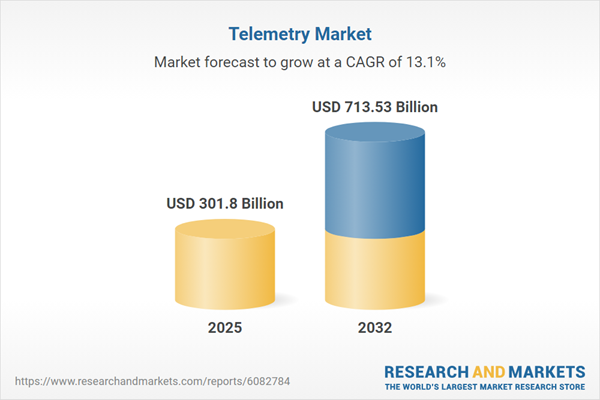Speak directly to the analyst to clarify any post sales queries you may have.
The telemetry market is experiencing rapid transformation as advanced data capture, connectivity, and analytics redefine how enterprises monitor and optimize complex operations. Senior decision-makers navigating this sector must understand both the technological evolution and the strategic pressures shaping investment decisions.
Market Snapshot: Telemetry Market Size, Growth, and Opportunity
The telemetry market grew from USD 266.81 billion in 2024 to USD 301.80 billion in 2025, with a projected CAGR of 13.08% set to drive the market to USD 713.53 billion by 2032. This trajectory underscores the critical role telemetry plays in digital transformation, operational transparency, and risk mitigation across major industries.
Scope & Segmentation of the Telemetry Market
- Component: Hardware (data loggers, gateways, sensors), Services (consulting, integration, support), Software (analytics, platform, security)
- Application: Automotive (autonomous, infotainment, telematics), Consumer Electronics (smart home, wearables), Healthcare (asset tracking, patient monitoring, remote diagnostics), Industrial (manufacturing, mining, oil & gas, transportation), Utilities (gas, power, water)
- Connectivity: Cellular (3G, 4G, 5G), LPWAN (LoRaWAN, NB-IoT, Sigfox), Satellite (GEO, LEO, MEO), Wi-Fi (Wi-Fi 5, Wi-Fi 6), Wired (Ethernet, RS-485)
- End User: Healthcare (home care, hospitals), Manufacturing (automotive, electronics, food & beverage), Oil & Gas (downstream, midstream, upstream), Transportation & Logistics (maritime, rail, road), Utilities (electricity, gas, water)
- Deployment Model: Cloud (private, public), Hybrid, On Premise (managed, self-hosted)
- Regional Coverage: Americas (including North America and Latin America), Europe, Middle East & Africa (Europe, Middle East, Africa), Asia-Pacific (major economies across East, South, and Southeast Asia)
- Solutions Providers Evaluated: Leading technology firms and integrated platform vendors shaping the competitive landscape
Key Takeaways for Senior Decision-Makers
- Artificial Intelligence and edge computing are propelling telemetry systems from passive data collection to active, predictive, and autonomous decision-making tools.
- Deployment flexibility enables enterprises to tailor strategies for real-time responsiveness and regulatory compliance by leveraging modular, interoperable architectures.
- New connectivity standards, such as LPWAN and advanced 5G, are expanding telemetry applications to previously inaccessible or cost-sensitive environments while optimizing network resources.
- Increasing integration of telemetry with digital twins and remote diagnostics is unlocking advanced operational models across manufacturing, healthcare, and utilities.
- Regional trends reveal that regulatory landscapes, infrastructure maturity, and capital investment cycles require localized implementation strategies for optimal market penetration.
- Collaborative vendor partnerships and strategic alliances are becoming key to rapid innovation and risk mitigation in the evolving competitive environment.
Tariff Impact: Navigating Trade Policy Shifts
Forthcoming United States tariffs on imported telemetry components and hardware are expected to reshape supply chains and procurement strategies. Manufacturers must consider nearshoring, renegotiation with domestic producers, and local partnerships to sustain competitiveness and control delivery risks. Service providers are adjusting terms and alliances to adapt to new sourcing realities, while government procurement may favor domestic innovation at the potential cost of limited access to global technologies.
Methodology & Data Sources
This report leverages primary interviews with market leaders, structured quantitative surveys, and comprehensive secondary research, including regulatory analyses and technical literature. Systematic triangulation of findings, with expert panel validation, ensures both qualitative and quantitative accuracy.
Why This Report Matters: Strategic Value for Executives
- Provides actionable insights on modular architecture adoption, advanced analytics, and supply chain resilience critical for competitive advantage in telemetry markets.
- Enables senior leaders to identify region-specific growth opportunities and respond proactively to changing tariff and regulatory conditions.
- Supports informed vendor selection and solution roadmap development amidst rapidly evolving technology ecosystems.
Conclusion
Decision-makers who prioritize strategic procurement, integration flexibility, and continuous technology advancement will maximize telemetry-driven performance gains. The evolving ecosystem rewards agility and collaboration, defining the path forward in this innovation-intensive landscape.
Table of Contents
3. Executive Summary
4. Market Overview
7. Cumulative Impact of Artificial Intelligence 2025
Companies Mentioned
The companies profiled in this Telemetry market report include:- Amazon Web Services, Inc.
- Microsoft Corporation
- Google LLC
- IBM Corporation
- Cisco Systems, Inc.
- Siemens AG
- Schneider Electric SE
- General Electric Company
- Honeywell International Inc.
- PTC Inc.
Table Information
| Report Attribute | Details |
|---|---|
| No. of Pages | 188 |
| Published | November 2025 |
| Forecast Period | 2025 - 2032 |
| Estimated Market Value ( USD | $ 301.8 Billion |
| Forecasted Market Value ( USD | $ 713.53 Billion |
| Compound Annual Growth Rate | 13.0% |
| Regions Covered | Global |
| No. of Companies Mentioned | 11 |









